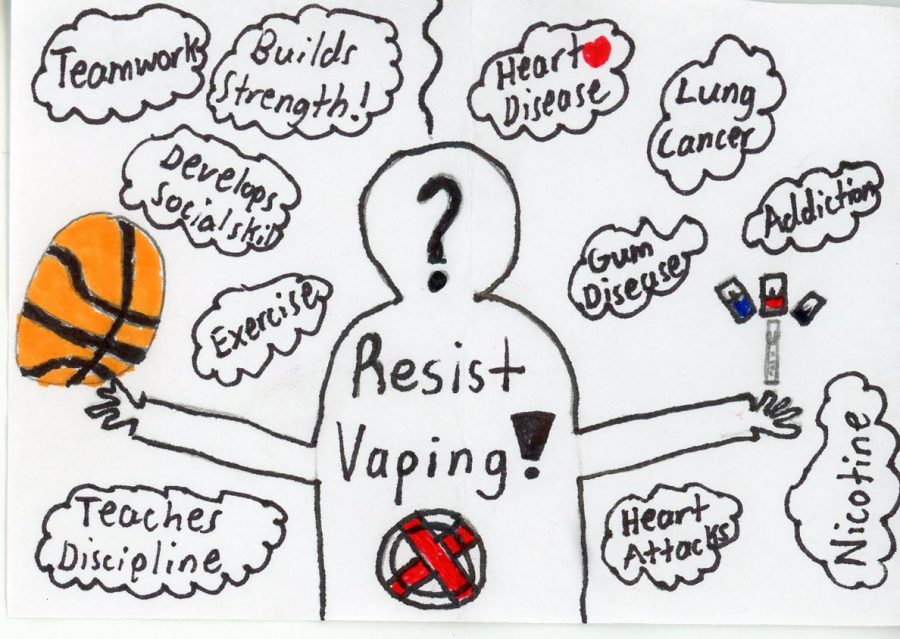Addictions/ Use
This week's blog topic was interesting because this conversation is vital to America's youth. Young students today deem vaping to be cool, trendy, and easily accessible. The youtube video shows kids interviewing and speaking about how they are easy to take with you anywhere, and how they can be hid in your shoe, sock, backpack, pocket, or anything really. Children can be stealthy with these tragic and turmoil devices. It is truly saddening to even put children and vaping within the same sentence, but it is true, children are the main targets are these cancer sticks.
The video we watched, "Vaping in Schools: 'Juuling' Is Popular Among Teens Despite Health Risks" highlighted many of the problems with America's youth. America's youth deems vaping to be a new fab or fashion, when in reality it is just a way to possibly shorten or hinder their adult lives. There is no stereotype for people who vape or juul, they are athletes, honors students, artists, and everything in between. However, kids are often mistaken thinking that they are inhaling water vapor, but in reality it is equivalent to smoking a pack of cigarettes, which contain high nicotine volumes. Children need to stop thinking that these actions and addictions are not cool, they are life threatening.
“It’s been a challenge for us administratively in all of education, and it’s a challenge in society,” (Superville, Prothero, 2019.) The article "The Student Vaping Crisis: How Schools Are Fighting Back" discusses the difficulties surrounding tackling the vaping addictions in youth today. It mentions ways to prevent students vaping all together because many“...Would rather convince a kid to not start, than to ever have to convince them to stop,” (Superville, Prothero, 2019.) In fact the school in the article instituted devices in the bathroom that notify teachers if someone is vaping. Additionally, what once was individual protocols for schools, has become an across the board community approach to help the cause. As educators, we are helping students develop their brains, and adults fear that these juuls will have long term effects on their brains. The article also discusses how to reach children, and feels fear like tactics are ineffective;“The reason why is, if students are suspended and they aren’t being educated, I’m not sure if they’re not going home and juuling, for example, if their parents are off at work,” (Superville, Prothero, 2019.) Students genuinely will not stop until they themselves see the wrong in juuling and have instilled the fear of it within themselves.
The website, Substance Abuse and Mental Health Services Administration provided multiple links and urls to click on. I went to the website linked to the National Institute of Mental Health. The website provided information of substance abuse and how it is diagnosed and treated. Something it said was "A substance use disorder (SUD) is a mental disorder that affects a person’s brain and behavior, leading to a person’s inability to control their use of substances such as legal or illegal drugs, alcohol, or medications" (National Institute of Mental Health.) This gave me a new perspective for when I am an educator because I never linked addiction to being a mental disorder truthfully. I always deemed addiction to be a person's inability to just stop something bad for them. Another aspect that could help us educators, if was more youth joined the clinical trials mentioned on the website. If teens joined these we could see how to fix the problem and just how bad it is.
Alcohol and Drug Addiction Happens in the Best of Families (2012). U.S. Department of Health and Human Services Substance Abuse and Mental Health Services Administration. LinkSuperville, R.A. & Prothero, A. (2019, August 27). The student vaping crisis: How schools are fighting back. Education Week. LinkVaping in Schools: 'Juuling' is Popular Among Teens Despite Health Risks. (2018). PBS News Hour. Retrieved on October 29, 2020 from Link

Comments
Post a Comment